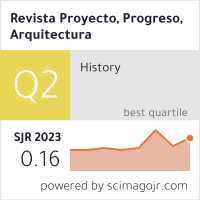LA ESTRUCTURA ORGÁNICA EN LOS RASCACIELOS DE FRANK LLOYD WRIGHT / The organic structure in the skyscrapers of Frank Lloyd Wright
DOI:
https://doi.org/10.12795/ppa.2013.i8.07Palabras clave:
Frank Lloyd Wright, rascacielos, conexión espacial, estructura orgánica, columna hueca, hormigón / Frank Lloyd Wright, skyscrapers, spatial connection, organic structure, hollow column, concreteResumen
RESUMEN La estructura de la modernidad, en general, está al servicio de una nueva concepción espacial fluida y continua, condensada en torno al concepto de “planta libre”. Sin embargo, la riqueza y complejidad de articulación que adquieren las plantas, no se observa en la sección de los edificios, especialmente si se trata de rascacielos. El principio de crecimiento por superposición de plantas iguales y el carácter utilitario de la estructura en esta tipología, anularon su carácter iconográfico y su integración espacial. Frank Lloyd Wright, de modo natural, desarrolla una estructura para sus escasos rascacielos que integra espacio y forma, superando así tanto la simplificación funcional de la Escuela de Chicago, como el valor iconográfico de las experiencias europeas.
SUMMARY In general, the structure of modernity serves a new, fluid and continuous, spatial conception, condensed around the “free floor” concept. However, the wealth and complexity of articulation that these floors acquire are not seen in the section of the buildings, especially in the case of skyscrapers. The principle of growth by superimposition of equal floors and the utilitarian character of the structure in this type of building, nullify the iconographic character of the structure and its spatial integration. Frank Lloyd Wright develops a structure for his few skyscrapers that integrates space and form in a natural way, thus surpassing both the functional simplification of the Chicago School, and the iconographic value of the European experiences.
Descargas
Citas
Brooks, Allen: “Wright and the Destruction of the Box”. En Journal of the Society of Architectural Historians. Marzo 1979, Nº 38.
Buitenhuis, Peter: “Aesthetics of the Skycraper: The views of Sullivan, James and Wright”. En American Quarterly [en línea]. Autumn 1957, Vol. 9. Nº 3. Disponible en: http://dx.doi.org/10.2307/2710531
Giedion, Sigfried: Espacio, tiempo y arquitectura. Barcelona: Editorial Reverté S.A., 2009 (edición definitiva).
Hearn, M.F.: “A Japanese Inspiration for Frank Lloyd Wright’s Rigid-Core High-Rise Structures”. En Journal of the Society of Architectural Historians. Marzo 1991, Nº 1.
Hitchcock, Henry-Russell: In the Nature of Materials. 1887-1941. The Buildings of Frank Lloyd Wright. New York: Duell, Sloan and Pearce, 1942 (PMCid:2601153).
Hoffmann, Donald: Frank Lloyd Wright, Louis Sullivan and the Skyscraper. New York: Dover Publications Inc., 1998.
Levine, Neil: “Frank Lloyd Wright’s Diagonal Planning”. En Searing, Helen (Ed.): In Search of Architecture: A Tribute to Henry-Russell Hitchcock. The Architectural History Foundation - MIT Press, 1982.
Lipman, Jonathan: Frank Lloyd Wright and the Johnson Wax Buildings. Nueva York: Rizzoli, 1986.
Manson, Grant: “Frank Lloyd Wright and the tall building”. En AA. VV.: Four great makers of Modern Architecture. Gropius, Le Corbusier, Mies van der Rohe, Wright. New York: School of Architecture of Columbia University, 1961.
McCarter, Robert: Frank Lloyd Wright. London: PhaidonPress Ltd., 1997. PMCid:178667
Pfeiffer, Bruce Brooks: Treasures of Taliesin. Seventy-Seven Unbuilt Designs. San Francisco: Pomegranate Communications Inc., 1985.
Pfeiffer, Bruce Brooks (Ed.): Frank Lloyd Wright: Collected Writings, vol. 2. New York, 1992.
Rowe, Colin: “La estructura de Chicago”. En Rowe, Colin: Manierismo y arquitectura moderna y otros escritos. Barcelona: Editorial Gustavo Gili, 1999.
Sanz Esquide, José A. (Coord.): Frank Lloyd Wright. Barcelona: Ediciones del Serbal, 1990.
Sullivan, Louis Henry: “The Tall Office Building Artistically Considered”. En Lippincot’s Magazine, 1896, Vol. 57.
Wright, Frank Ll.: Autobiografía 1967-1944. Madrid: El Croquis Editorial, 1998.
Wright, Frank Ll.: “Sky City Plan No Idle Dream, Says Wright”. En Chicago Tribune. Octubre 1956.
Descargas
Publicado
Cómo citar
Número
Sección
Licencia
Las ediciones impresa y electrónica de esta Revista son editadas por el Secretariado de Publicaciones de la Universidad de Sevilla, siendo necesario citar la procedencia en cualquier reproducción parcial o total.
Salvo indicación contraria, todos los contenidos de la edición electrónica se distribuyen bajo una licencia de uso y distribución “Creative Commons Atribución-NoComercial-SinDerivar 4.0 Internacional” ![]() . Puede consultar desde aquí la versión informativa y el texto legal de la licencia. Esta circunstancia ha de hacerse constar expresamente de esta forma cuando sea necesario.
. Puede consultar desde aquí la versión informativa y el texto legal de la licencia. Esta circunstancia ha de hacerse constar expresamente de esta forma cuando sea necesario.
Los autores/as que publiquen en esta revista aceptan las siguientes condiciones:
- Los autores/as conservan los derechos de autor y ceden a la revista el derecho de la primera publicación, con el trabajo registrado con la licencia de atribución de Creative Commons, que permite a terceros utilizar lo publicado siempre que mencionen la autoría del trabajo y a la primera publicación en esta revista.
- Los autores/as pueden realizar otros acuerdos contractuales independientes y adicionales para la distribución no exclusiva de la versión del artículo publicado en esta revista (p. ej., incluirlo en un repositorio institucional o publicarlo en un libro) siempre que indiquen claramente que el trabajo se publicó por primera vez en esta revista.
- Se permite y recomienda a los autores/as a publicar su trabajo en Internet (por ejemplo en páginas institucionales o personales) antes y durante el proceso de revisión y publicación, ya que puede conducir a intercambios productivos y a una mayor y más rápida difusión del trabajo publicado (vea The Effect of Open Access).









